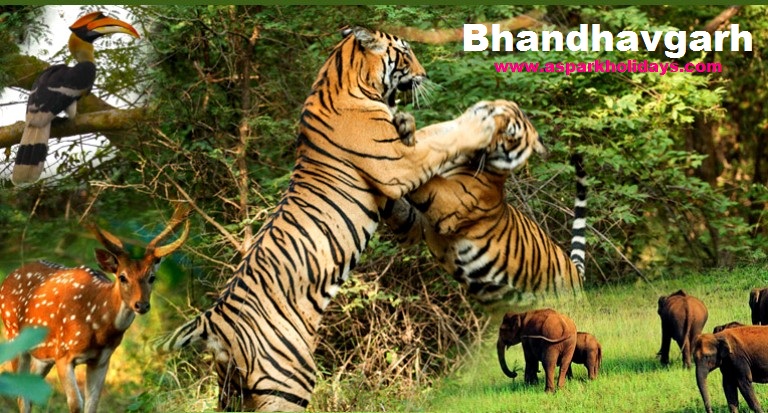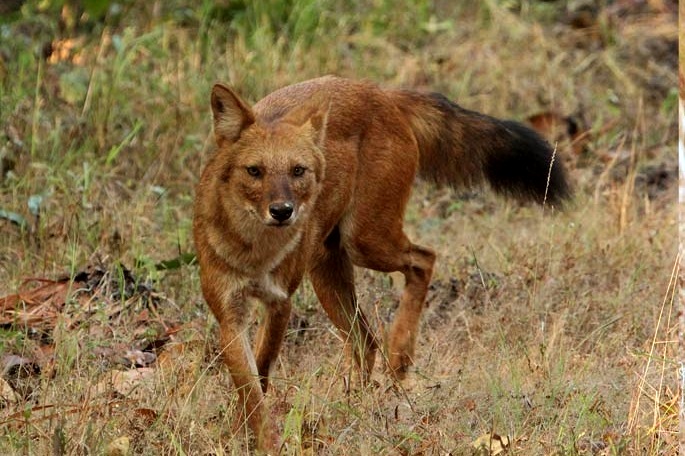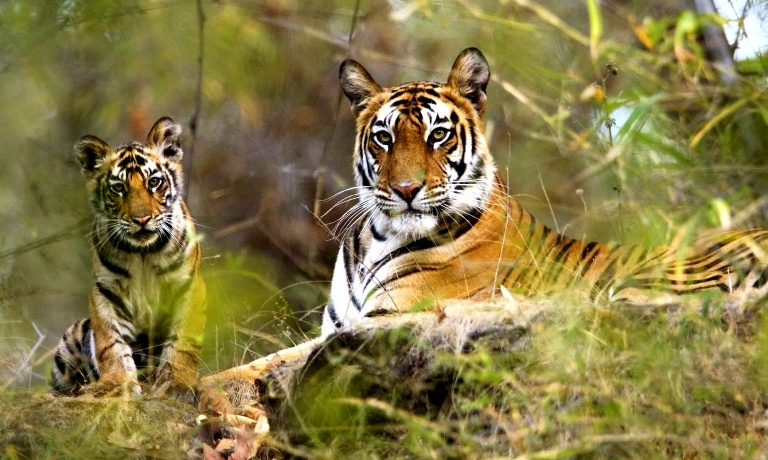
Bandhavgarh Location- Bandhavgarh location Bandhavgarh is located in the north eastern border of Madhya Pradesh, the central state of India. It lies in the umaria-shahdol district surrounded by satpura mountain range. The latitutde and longitudes are 23° 30' to 23°46' N and 80° 11' to 36' E. The altitude is between 410 m and 810 m. The mountains of bandhagarh tala range are generally composed of sandstone. The soil is generally sandy to sandy-loam. More than tweny streams rise or flow through the park. Some of the important streams of bandhagarh are Johilla, janadh, charanganga, Damnar, banbei, Ambanala and andhiyari Jhiria. All these streams merge into the son river, which is an important southern tributary to the Ganges.
Places of Interest Inside the Park- Bandhavgarh has region of important inside the park. Know more about the important areas info inside Bandhavgarh National Park in Madhya Pradesh India.
Siddhbaba Bandhavgarh Sidhbaba- This place is named after the holy temple of sidhbaba(god of indian worship). This is the most common point from where you can see the tiger near this temple. There is a large marshy meadow behind this temple where wild fauna can be easily witnessed. Here you will find almost guranteed sighting of sambhar, chital, painted stroke and sometimes wildboars. The sidhbaba region was the territory of some the main tiger of bandhavgarh such as charger and bokha.
Charkadhara- Charkradhara area is a large meadow area inside the park popular for the tiger sighting. During the summers this meadow looks like a open hunting ground for the predators. The charkradhara meadow is surrounded by hilly regions. It is a marshy meadow which is rich in flora and fauna. As the availability of food, water and hiding grass is through out the year, so the wlid animals can be easily sighted in this region.
Gopalpur- Gopalpur region is at the north east region of bandhavgarh national park. This region is a marshy area always filled with river water. The aquatic plants and mammals are rich in this area which makes the area suitable for bird watching. So of the birds which can be easily sighted in the gopalpur region is Kingfishers, painted storks, lapwings and stilts.
Sheesh Shaiya Bandhavgarh Shesh Shaiya- This 65 ft horizontally laid idol of lord vishnu is the origin of river charanganga. The reclining statute of lord vishnu on the seven hooded serpent is the architechture of the past. the vicinity is rich with fruit bearing trees. On the ocassion of Diwali , the biggest festival of hindus, people use to decorate lamps around the vishnu Idol. Watch out for the malabar pied hornbill near shesh shayia.
Bari Gufa- 'Badi Gufa' in english means the biggest cave. This cave is one of the biggest caves in the bandhavgarh national park region which dates back to the tenth century. This caves is being made by carving the solid rock of sandstone. These caves were the shelters of the army of the king during the medivial period. Now the caves are home to wide variety of bats. The badi gufa is a man made cave not a natural one. Visit the bandhavgarh ancient caves page for the names of the caves of bandhavgarh reserves.
Ketkiha- This wet region inside the bandhavgarh reserve is full of aromatic plant "Pendanus". That why it is also known as pendanus point. The indian name of pendanus plant is kewra. This region is surrounded by the shadows of lofty Jamun and Arjun trees.
Three Cave Pont- The three cave point is visible from the ganesh hillock road. It is a classic example of the prevalent architechural techniques used during the past. The caves now porvied the shelter for the wild animals like tiger, sloth bear and even for the leopards.
Sita Mandap- The name of this region resembles the wedding ground of the wife of lord rama. The meaning of Mandap itself wedding ground. It is a single rock which arches over like a bridge. The mandap also looks similar to this rock arch. The Name of the famous tigress sita is being named after this place. sita is the mother of the most of the tigers and tigeress in bandhavgarh reserve area.
Ghorademaon- This is a natural deep george which is a result of geographical processes The water flows continously in this region. You can listen the song of the jungle near this waterbody.
The Photographer's Point- This point is on the way when we drive back from the Route B. This point is the mountain top which gives a paniramic view of the bandhavgarh widlife sanctuary. The Photography from this point is not allowed for every visitors. Special permission is to be taken from the forest director for the photography purpose.
Andheri Jhiria- The Tigers during the summers spend their afternoon in this region as this area is mostly covered with the shadows of the trees. There is a spring water source in this area from where the water comes out through out the year even during the summer. As the region is darkened by shadows, it is commonly difficult to see the tiger in Andheri Jhiria.
Raj- Bahera- The rajbahera region is a marshy meadow which feeds the chitals, sambhar and wild boars. The river damnar originates from Rajbahera. Different species of birds can be easily sighted from this area. You can also see the bandini hills from this region.
Charger's Place- Charger the dominant male in bandhavgarh who ruled the jungle for over a decade. This place was the resing ground of Charger. he died in the year 2000. Charger holds the record to the most photographed male tiger in the world. he died due this natural death. When he died it was very difficult to locate as during the last time of their life they hide in a very secret place where no boady can approach
Bandhavgarh Climate Bandhavgarh Climate- Bandhavgarh lies on the extreme north - eastern border of the present state of Madhya Pradesh in India and the northern flanks of the eastern Satpuda mountain range. The climate of bandhavagrh is a north indian monsoonal. It is mainly characterised by well - defined winters, summers and rains. During the winters the mercury falls upto 2° C in the month of January and during the summers it goes upto 45° C. Average rainfall of 1133 mm, most of which pecipitates during the monsoons. Some rains result from the southern cyclones as well, between the months of November and february.
Best time to visit Bandhavgarh- Bandhavgarh Tiger Reserve remains open from October to June months for visitors. So one can visit the park at any day during these months. In monsoon, i.e. in the months of July August September, Bandhavgarh Park remains closed for visitors. So we can conclude that we can visit park during winters & summers. Bandhavgarh National Park is spread over Vindhya ranges in Madhya Pradesh State of Central India. In first two months, after opening of park, i.e. during October and November, climate remains pleasant as after monsoon departure, we can find greenery everywhere in the forest area with plenty of water-holes. Winter season lasts for 3-months in Bandhavgarh, December January February. March & April (first half) are the Spring seasons but day time temperature will make you feel hot as temperature will start reaching 40 degree Celsius in day time. From second-half of April to June, sunlight express his strong presence with heat-waves, dryness in jungle, disappearance of water-holes and a peculiar silence in the forest.
Best time to visit Bandhavgarh National Park varies with the aim with which we are intending to visit the forest. If we are interested in migratory bird watching in green surrounding of forest, perennials then from October to January months will be more suitable for us. Temperature will remain below 30 degree Celsius. During this time we can enjoy greenery of forest, plenty of water sources and birds around them. Similarly, tigers can also be seen is areas other than Tala zone like Magdhi Zone (Gate-2) and Khitauli Zone (Gate-3) as water sources in those zones remain alive and grasslands will ease the availability of prey in those areas. We can find even distribution of tigers and other animals during this time. Accommodation problem may arise in the months of November & December as these are festival season in India due to which domestic tourist visits the forest most at this time as a family vacation tour so advance accommodation booking would be the better option to follow.
Those who are interested in birding, tiger-sighting along with other mammals sighting, they can visit the park during January - February - March months. During this time temperature will remain below 25 degree Celsius which makes the weather cool and pleasant so safari will be problem. In the months of February and March, flowers in Flame of Forest tree make the jungle more photogenic and attract birds around them, sloth bears to come out more frequently. With the presence of Mahua (Madhuca longifolia), the fruit of Indian Butter Tree attracts most of the herbivores and omnivores animals of Bandhavgarh forest. Sambars, Blue-bull, Sloth Bear, Spotted deer, Languar monkeys can be seen more often in open. During this time, domestic tourism falls down due to examinations in schools so accommodation availability will not pose any problem from domestic tourism side.
Months of April May June are considered the best time to do wildlife photography and tiger photography. During this time, we can expect unusual photography of tigers as heat causes animals to remain close to water sources. Limited water sources will enable us to predict the animal location more accurately. During this time Tala Zone have good number of active water sources and the area have hills of sand-stone that retain water from long time and also felt cool during day time so tiger sighting chances in Tala Zone are far better than any other tourist zones of Bandhavgarh National Park. Close to water source, we may be lucky enough to find unusual photographs of tiger making kill or resting in water etc. Sighting of Tigress with cubs can be possible in early morning hours and just before sunset as tiger mating mostly take place in the months of November “ December January February so cubs born from 110 days of gestation period can be seen during this time. Similarly, birds can also be seen close to water sources. Spotted deer herds under Indian Butter Tree are the most commons scenes of forest. Due to dryness in trees, fall of leaves in Sal trees and disappearance of bushes causes more penetration capacity to watch distant animals also. For Bird watchers, Khitauli Zone is considered good as here water sources at Bamera Dam, Khitauli reservoir offers scope for birding around them. Blue bull or Nilgai antelope and sloth bear sighting in this zone is also good compare to other tourist zones of Bandhavgarh.
Need Aspark Help?
For Tour Packages, Vehicle Rental and Customer Care Support.
+91 9999 31 7846
booking@asparkholidays.comWhy Travel with Us?

Excellent Support
Our Team Available 24x7 for Customer support
Best Price & Savings
We Offer the Most Competitive Prices.


